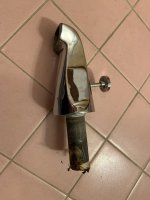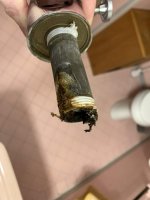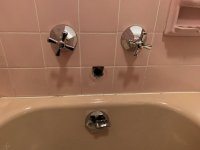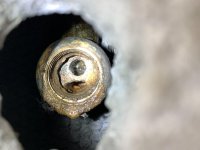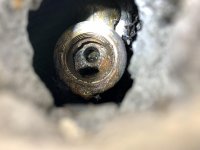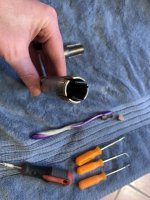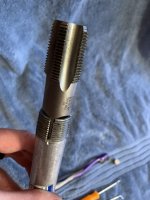Mr. Lahey
New Member
My 1950's era ranch had a leaky diverter valve - about half the water would come from the tub spout vs. the shower head when the diverter was engaged. Intending to replace it, I attempted to unthread the diverter first by hand, and then with a pipe wrench, with a piece of leather to avoid marring the diverter.
The threads on the inside-end of the galvanized nipple (3/4" NPT, about 3.5" long) sheared off, due to severe corrosion. Now I'm left with a partial set of clean brass threads on the top of the inside fitting, and another clump of rusted steel locked into threads on the bottom.
I've already tried picking and jabbing to see what comes loose - not much. I don't think that a nipple extractor would work, because it would bite into the exposed brass female threads first.
Any ideas before I tear open the wall from the other side? I'm hoping to keep the pink tile - getting rarer these days!
Also, the inside brass fitting appears to have two passageways. It looks like a regular threaded elbow, but there are clearly two holes inside. Is anyone familiar with this tub/shower valve? I don't see any manufacturers marks on anything. My guess is that the hot and cold water come from the top, and get pushed back through the bottom passage, to the shower head.
The threads on the inside-end of the galvanized nipple (3/4" NPT, about 3.5" long) sheared off, due to severe corrosion. Now I'm left with a partial set of clean brass threads on the top of the inside fitting, and another clump of rusted steel locked into threads on the bottom.
I've already tried picking and jabbing to see what comes loose - not much. I don't think that a nipple extractor would work, because it would bite into the exposed brass female threads first.
Any ideas before I tear open the wall from the other side? I'm hoping to keep the pink tile - getting rarer these days!
Also, the inside brass fitting appears to have two passageways. It looks like a regular threaded elbow, but there are clearly two holes inside. Is anyone familiar with this tub/shower valve? I don't see any manufacturers marks on anything. My guess is that the hot and cold water come from the top, and get pushed back through the bottom passage, to the shower head.

